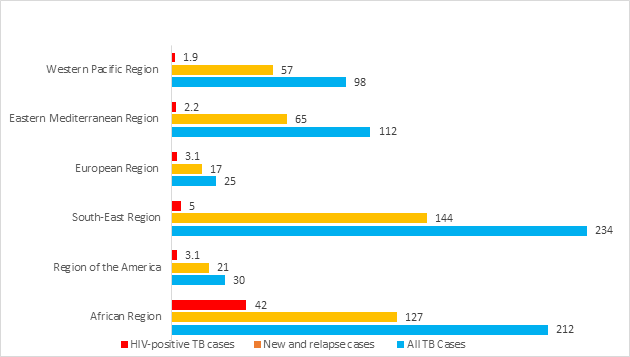Short Overview of The Burden of Tuberculosis
Abstract
Tuberculosis has been a common infectious disease among humans since ancient times. Mycobacterium tuberculosis can affect different parts of the human body – commonly, human lungs. Tuberculosis is one of the significant public health issues in most countries. According the World Health Organization (WHO) globally, tuberculosis kills approximately 2 million people every year, and 10 million new cases were diagnosed in 2019 (WHO, 2020). The primary source of infection in the community is people who have smear-positive Mycobacterium tuberculosis and their sputum. Among people infected with Mycobacterium tuberculosis, 5 to 10% of people might develop clinical manifestations of the disease. The emergence of clinical manifestation is significantly increased in HIV-positive people (Harries & Dye, 2006).
References
Bjelakovic, G., Nikolova, D., Gluud, L. L., Simonetti, R. G., & Gluud, C. (2007). Mortality in randomized trials of antioxidant supplements for primary and secondary prevention: systematic review and meta-analysis. JAMA, 297(8), 842-857.
Carter, D. J., Glaziou, P., Lönnroth, K., Siroka, A., Floyd, K., Weil, D., Raviglione, M., Houben, R. M. G. J., & Boccia, D. (2018). The impact of social protection and poverty elimination on global tuberculosis incidence: a statistical modelling analysis of Sustainable Development Goal 1. The Lancet. Global Health, 6(5), e514–e522. https://doi.org/10.1016/S2214-109X(18)30195-5
Desa, U. N. (2016). Transforming our world: The 2030 agenda for sustainable development.
Falzon, D., Mirzayev, F., Wares, F., Baena, I. G., Zignol, M., Linh, N., & Raviglione, M. (2015). Multidrug-resistant tuberculosis around the world: what progress has been made?. European Respiratory Journal, 45(1), 150-160.
Fitchett, J. R., MacPherson, P., & Corbett, E. L. (2016). Implementing the End TB Strategy and the intersection with the Sustainable Development Goals, 2016–2030. Transactions of the Royal Society of Tropical Medicine and Hygiene, 110(3), 145-147.
Gupta, R. K., Lucas, S. B., Fielding, K. L., & Lawn, S. D. (2015). Prevalence of tuberculosis in post-mortem studies of HIV-infected adults and children in resource-limited settings: a systematic review and meta-analysis. AIDS (London, England), 29(15), 1987.
Harries, A. D., & Dye, C. ‘Tuberculosis (Centennial review). Annals of Tropical Medicine & Parasitology, 100, 5.
Herbert, N., George, A., Sharma, V., Oliver, M., Oxley, A., Raviglione, M., & Zumla, A. I. (2014). World TB Day 2014: finding the missing 3 million. The Lancet, 383(9922), 1016-1018.
Krieger, N. (2012). Methods for the scientific study of discrimination and health: an ecosocial approach. American journal of public health, 102(5), 936-944.
Lönnroth, K., & Raviglione, M. (2016). The WHO's new End TB Strategy in the post-2015 era of the Sustainable Development Goals. Transactions of the Royal Society of Tropical Medicine and Hygiene, 110(3), 148-150.
MacNeil, A., Glaziou, P., Sismanidis, C., Maloney, S., & Floyd, K. (2019). Global epidemiology of tuberculosis and progress toward achieving global targets—2017. Morbidity and Mortality Weekly Report, 68(11), 263.
Ortblad, K. F., Salomon, J. A., Bärnighausen, T., & Atun, R. (2015). Stopping tuberculosis: a biosocial model for sustainable development. The Lancet, 386(10010), 2354-2362.
Raviglione, M., & Sulis, G. (2016). Tuberculosis 2015: burden, challenges and strategy for control and elimination. Infectious disease reports, 8(2), 33-37.
Siroka, A., Ponce, N. A., & Lönnroth, K. (2016). Association between spending on social protection and tuberculosis burden: a global analysis. The Lancet Infectious Diseases, 16(4), 473-479.
Uplekar, M., Weil, D., Lonnroth, K., Jaramillo, E., Lienhardt, C., Dias, H. M., & Raviglione, M. (2015). WHO's new end TB strategy. The Lancet, 385(9979), 1799-1801.
World Health Organization (2024a). TB mortality. https://www.who.int/teams/global-tuberculosis-programme/tb-reports/global-tuberculosis-report-2022/tb-disease-burden/2-2-tb-mortality.
World Health Organization (2024b). 2.1 TB incidence. https://www.who.int/teams/global-tuberculosis-programme/tb-reports/global-tuberculosis-report-2022/tb-disease-burden/2-1-tb-incidence.
World Health Organization. (2020). Tuberculosis. World Health Organization.
World Health Organization. (2018). Global tuberculosis report 2018. World Health Organization.
World Health Organization. (2013). Global tuberculosis report 2013. World Health Organization.
-
Article Viewed: 0
Total Download
##plugins.themes.ojsPlusA.frontend.article.downloadstatastics##



